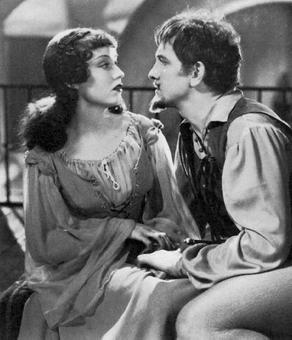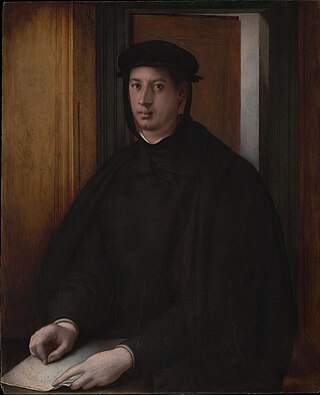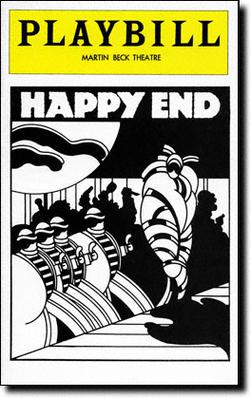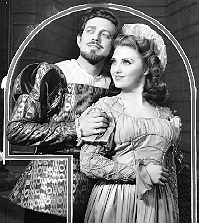
Pope Leo XI, born Alessandro Ottaviano de' Medici, was head of the Catholic Church and ruler of the Papal States from 1 April 1605 to his death, in 27 April 1605. His pontificate is one of the briefest in history, having lasted under a month. He was from the prominent House of Medici originating from Florence. Medici's mother opposed his entering the priesthood and sought to prevent it by having him given secular honours, but after her death he eventually was ordained a priest in 1567. In his career he served as Florence's ambassador to the pope, Bishop of Pistoia, Archbishop of Florence, papal legate to France, and as the cardinal Prefect for the Congregation of the Bishops and Religious. He was elected to the papacy in the March 1605 papal conclave and served as pope for 27 days.

The Affairs of Cellini is a 1934 American historical comedy film directed by Gregory La Cava and starring Frank Morgan, Constance Bennett, Fredric March, Fay Wray, and Louis Calhern. It is set in Florence. The film was adapted by Bess Meredyth from the play The Firebrand of Florence by Edwin Justus Mayer.

Benvenuto Cellini was an Italian goldsmith, sculptor, and author. His best-known extant works include the Cellini Salt Cellar, the sculpture of Perseus with the Head of Medusa, and his autobiography, which has been described as "one of the most important documents of the 16th century".

Cosimo I de' Medici was the second Duke of Florence from 1537 until 1569, when he became the first Grand Duke of Tuscany, a title he held until his death.

Ludovico Maria Sforza, also known as Ludovico il Moro and termed the "arbiter of Italy" by historian Francesco Guicciardini, was an Italian Renaissance nobleman who ruled as Duke of Milan from 1494 to 1499.

Alessandro de' Medici, nicknamed "il Moro" due to his dark complexion, Duke of Penne and the first Duke of the Florentine Republic, was ruler of Florence from 1530 to his death in 1537. The first Medici to rule Florence as a hereditary monarch, Alessandro was also the last Medici from the senior line of the family to lead the city. His assassination at the hands of distant cousin Lorenzaccio caused the title of Duke to pass to Cosimo I de Medici, from the family's junior branch.

Benvenuto Cellini is an opera semiseria in four tableaux by Hector Berlioz, his first full-length work for the stage. Premiered at the Académie Royale de Musique on 10 September 1838, it is a setting of a libretto by Léon de Wailly and Henri Auguste Barbier, who invented most of the plot inspired by the memoirs of the Florentine sculptor Benvenuto Cellini. The opera is technically challenging and was until the 21st century rarely performed. But its overture sometimes features in orchestral concerts, as does the concert overture Le carnaval romain which Berlioz composed from material in the opera.
The Witch is a Jacobean play, a tragicomedy written by Thomas Middleton. The play was acted by the King's Men at the Blackfriars Theatre. It is thought to have been written between 1613 and 1616; it was not printed in its own era, and existed only in manuscript until it was published by Isaac Reed in 1778.

Street Scene is an American opera by Kurt Weill (music), Langston Hughes (lyrics), and Elmer Rice (book). Written in 1946 and premiered in Philadelphia that year, Street Scene is based on the Pulitzer Prize-winning 1929 play of the same name by Rice.

Happy End is a three-act musical comedy by Kurt Weill, Elisabeth Hauptmann, and Bertolt Brecht which first opened in Berlin at the Theater am Schiffbauerdamm on September 2, 1929. It closed after seven performances. In 1977 it premiered on Broadway, where it ran for 75 performances.

Peter de Witte, known in Italy as Pietro Candido and in Bavaria as Peter Candid was a Flemish-born Mannerist painter, tapestry designer and draughtsman active in Italy and Bavaria. He was an artist at the Medici court in Florence and at the Bavarian court of Duke William V and his successor Maximilian I in Munich.

The Duchess of Padua is a five-act tragedy by Oscar Wilde, set in Padua and written in blank verse. It was written for the actress Mary Anderson in early 1883 while Wilde was in Paris. After she turned it down, it was abandoned until its first performance at the Broadway Theatre in New York City under the title Guido Ferranti on 26 January 1891, where it ran for three weeks. It has been rarely revived or studied.
The Double Marriage is a Jacobean era stage play, a tragedy written by John Fletcher and Philip Massinger, and initially printed in the first Beaumont and Fletcher folio of 1647.

Ascanio is a grand opera in five acts and seven tableaux by composer Camille Saint-Saëns. The opera's French libretto, by Louis Gallet, is based on the 1852 play Benvenuto Cellini by French playwright Paul Meurice which was in turn based on the 1843 historical novel by Alexandre Dumas, père. The name was changed to Ascanio to avoid confusion with the Berlioz opera Benvenuto Cellini. The opera premiered on March 21, 1890, at the Académie Nationale de Musique in Paris, in costumes designed by Charles Bianchini and sets by Jean-Baptiste Lavastre and Eugène Carpezat, Auguste Alfred Rubé and Philippe Chaperon and Marcel Jambon.

Perseus with the Head of Medusa is a bronze sculpture made by Benvenuto Cellini in the period 1545–1554. The sculpture stands on a square base which has bronze relief panels depicting the story of Perseus and Andromeda, similar to a predella on an altarpiece. It is located in the Loggia dei Lanzi in the Piazza della Signoria in Florence, Italy. The second Florentine duke, Duke Cosimo I de' Medici, commissioned the work with specific political connections to the other sculptural works in the piazza. When the piece was revealed to the public on 27 April 1554, Michelangelo's David, Bandinelli's Hercules and Cacus, and Donatello's Judith and Holofernes were already installed in the piazza.

Francesco Sforza (1562–1624) was an Italian cardinal and bishop. He was very influential in a number of conclaves.
Bertlies "Lys" Symonette was a German-American pianist, chorus singer and musical stage performer. In 1945 she took a job as rehearsal pianist, coach, understudy or multi-tasking "swing-girl" for The Firebrand of Florence, a Kurt Weill musical making its Broadway debut. This proved to be the start of a new career as Weill's musical assistant: from that point a principal focus of her professional life was on the composer and, more particularly after his early death in 1950, the career of his widow, the stage performer Lotte Lenya. When Lenya died, in 1981, Lys Symonette was appointed vice-president of the Kurt Weill Foundation, also serving as its "musical executive". When she died her friend and frequent collaborator, Prof. Kim H. Kowalke, published an affectionate tribute in which he described her as "the last and irreplaceable link to the inner artistic circle of Weill and Lenya".

Berlin to Broadway with Kurt Weill is a musical revue with a book by Gene Lerner, music by Kurt Weill, and lyrics by various songwriting partners Weill worked with over his career. The plot follows Weill's life as he begins his career in Germany writing the music for controversial musicals, through his journey fleeing Nazi persecution, immigrating to the United States, and becoming successful on Broadway. Songs featured include those Weill collaborated on with Maxwell Anderson, Marc Blitzstein, Bertolt Brecht, Jacques Deval, Michael Feingold, Ira Gershwin, Paul Green, Langston Hughes, Alan Jay Lerner, Ogden Nash, George Tabori and Arnold Weinstein.
Antonio Altoviti was an Italian Catholic archbishop, son of Bindo Altoviti and archbishop of Florence from 1548 to 1573.

The Altoviti are a prominent noble family of Florence, Italy. Since the medieval period they were one of the most distinguished banking and political families appointed to the highest offices of the Republic of Florence, friends and patrons of Galileo Galilei, Vasari, Raphael, and Michelangelo. They had a close personal relationship with the papacy. Through a predominant endogamous marriage policy they established alliances with dynasties of principal and papal nobility as the Medici, Cybo, Rospigliosi, Sacchetti, Corsini, and Aldobrandini.
















